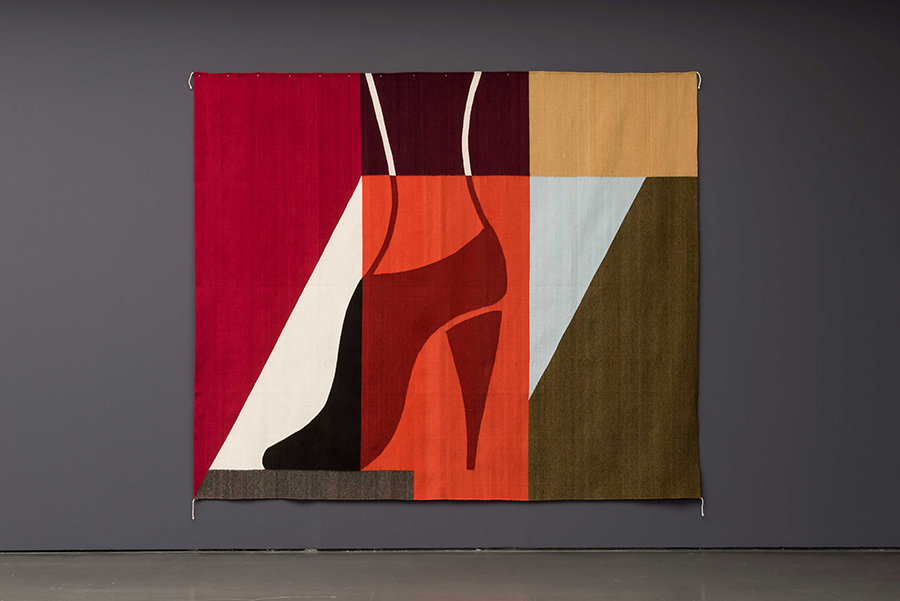Ulrike Müller's Dedramatized Formalism
An exhibition at Kunstverein Düsseldorf explores how the artist shifts and transforms the categories of visual identification
An exhibition at Kunstverein Düsseldorf explores how the artist shifts and transforms the categories of visual identification

Walking into Ulrike Müller’s exhibition, ‘Container’, the overriding impression is one of comfortable familiarity. The well-mannered compositions, which play out across upwards of 50 new, two-dimensional works, evoke some of the curvier episodes in the history of 20th-century abstraction. Their clear colours, clean contours and flat, rounded forms feel like updated takes on Hilma af Klint, Hans Arp or Sonia Delaunay, while the occasional lean into figuration and patterning brings to mind the late works of Henri Matisse, albeit well tranquilized in his senescence. Müller’s monotypes on paper even come replete with neat pencil signatures in the bottom right corner, an anachronistic throwback that seems especially absurd considering that none of the works on view have been hand-painted in the conventional sense. Here, Müller’s choice of materials and techniques asserts a space for painting beyond the once heroic and many-times deceased medium of oil on canvas: monotype on paper, vitreous enamel on steel and monumental rugs manufactured by Zapotec weavers in Oaxaca. Furthermore, the materials’ decidedly homely vibe is amplified by a remarkably effective accent wall of dark, warm grey, which manages to domesticate the Kunstverein’s vast and relentlessly illuminated main hall, making it almost feel inhabitable.

Almost all of the works on view have been produced in series. Their repetitions, however, are not systematic iterations of a rigid abstract principle. Instead, their elements casually convene and disperse across various images in a mutable progression of family resemblances or, for that matter, differences. What makes the consistency of Müller’s formal language so lively is not just the way the pieces cite each other, but also the parameters by which they vary. In the enamel work Step by Step (2010), for example, the hard edges of Müller’s high heels begin to dissolve, while in the domineering Rug (con tacón) (2018), the soles of the same motif wearily start to fray.
The connotation of bodies lies close at hand. All the works on view boast inviting surfaces and occasional anthropomorphic elements like eyes, breasts and high heels, while in works such as Popij and Pantry (both 2018), the exhibition’s titular container features prominently as a nondescript pitcher – a form that Freudian psychoanalysts have long associated with femininity and the womb. In a 2016 article, art theorist Kerstin Stakemeier has gone so far as to describe Müller’s forms as ‘comfortably gendered’. At a time when the extent of structural gender discrimination and violence has never been clearer, it seems both untimely and wisely prescient to ask what a more ‘comfortable’ relationship to gender could feel like, or even mean.

Müller’s work is unmistakably situated in what by now has become a well-established artistic tradition of historical modernism by other means. But visitors expecting edgy ripostes and symbolic antagonisms towards the master’s tools may find themselves disappointed. Müller’s formalism is far too fastidious, far too knowing to exhaust itself in gratifying ironies. Instead, she values the kind of coyness palpable in the monotype Hedge, one of the few pieces in the show presented as an individual work. Accordingly, visitors find themselves amidst a decidedly ‘dedramatized’ and mundane aesthetic daze where the categories of visual identification – size, material, shape – ever so gently shift and transform. Art historian Manuela Ammer has drawn a parallel between this aspect of Müller’s work and what Lauren Berlant has called ‘benign variation’. In Sex, or the Unbearable (2014), Berlant tentatively describes benign variation not just as an analogy to the process of genetic mutation but also as a strategy of representation that functions by way of curiosity and a certain optimism. Admittedly, it is hard for me to feel either while staring at abstract images. Nonetheless, Müller’s presentation succeeds in creating a prolonged and strangely anesthetized form of attention in which the play of differences and mutations starts to feel as natural as it should be. If history is the house we live in, it has rarely felt quite this cosy.
Main image: Ulrike Müller, 'Container', 2018, installation view. Courtesy: the artist and Kunstverein Düsseldorf; photograph: Katja Illner























